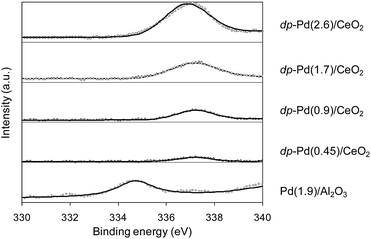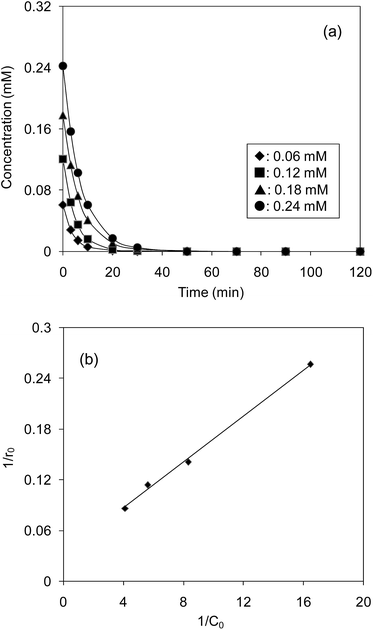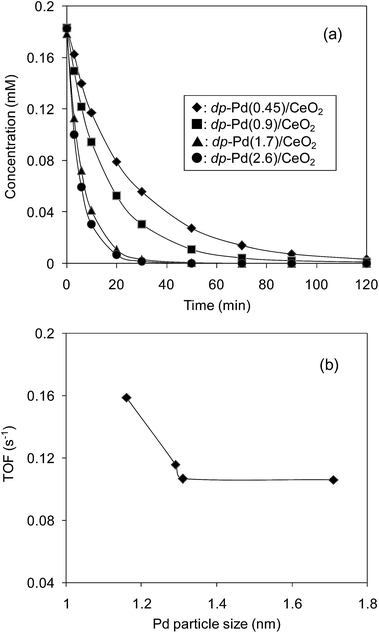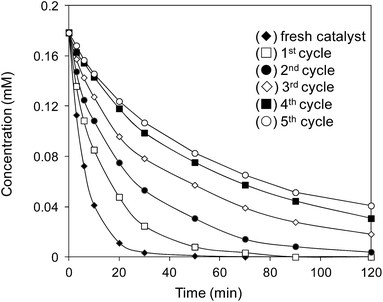Effective liquid phase hydrodechlorination of diclofenac catalysed by Pd/CeO2†
Ke Wu,
Xiaojun Qian,
Liangyan Chen*,
Zhaoyi Xu,
Shourong Zheng* and
Dongqiang Zhu
State Key Laboratory of Pollution Control and Resource Reuse, Jiangsu Key Laboratory of Vehicle Emissions Control, School of the Environment, Nanjing University, Nanjing 210093, China. E-mail: chenly@nju.edu.cn; srzheng@nju.edu.cn; Fax: +86-25-89680367; Fax: +86-25-89680596; Tel: +86-25-89680367 Tel: +86-25-89680373
First published on 6th February 2015
Abstract
Palladium catalysts supported on Al2O3, activated carbon (AC), SiO2 and CeO2 were prepared using the impregnation and deposition–precipitation methods. The liquid phase catalytic hydrodechlorination of diclofenac on the catalysts was investigated, and the toxicity of the original and treated diclofenac solutions was evaluated using Daphnia magna. Characterization results indicated that the Pd catalyst supported on CeO2 had a higher Pd dispersion than those supported on Al2O3, AC and SiO2. The binding energy of Pd 3d5/2 in Pd/CeO2 was higher than Pd/Al2O3 with a similar Pd loading amount. Additionally, for Pd/CeO2 prepared by the deposition–precipitation method the binding energy of Pd 3d5/2 slightly decreased with the Pd loading amount. As for catalytic diclofenac reduction, Pd/SiO2 exhibited a nearly negligible catalytic activity, whereas diclofenac concentration decreased by 100, 86, and 29% within 50 min of reaction on Pd/CeO2, Pd/Al2O3, and Pd/AC, respectively, indicative of a catalytic activity order of Pd/CeO2 > Pd/Al2O3 > Pd/AC > Pd/SiO2. The hydrodechlorination of diclofenac on Pd/CeO2 could be well described using the Langmuir–Hinshelwood model. Diclofenac hydrodechlorination processed via a combined stepwise and concerted pathway, and increasing Pd loading amount in Pd/CeO2 favoured the concerted pathway. In comparison with original diclofenac, catalytic hydrodechlorination of diclofenac led to markedly decreased toxicity to Daphnia magna.
1. Introduction
The occurrence of organic micropollutants like active pharmaceutical ingredients (APIs) in the aquatic environment has been receiving increasing attention in recent years.1 Due to insufficient biodegradation in sewage systems, APIs may eventually enter the aquatic environment. So far, the concentration of these pharmaceuticals in environmental matrices keeps rising from ng l−1 to μg l−1 levels.2,3 Among the relevant APIs, diclofenac is widely used as an analgesic and anti-inflammatory drug mainly in oral and dermal applications.1 Accordingly, it was detected in various water samples including wastewater treatment plant (WWTP) effluents and surface water. Toxicity tests indicated that diclofenac was harmful to the liver, kidney and gills of rainbow trout.4 Furthermore, diclofenac was found to be capable of inducing harmful effects similar to other APIs such as ibuprofen, naproxen, and acetylsalicylic acid.5,6 Hence, it is highly desirable to develop effective methods to eliminate diclofenac pollution prior to its discharge into the aquatic environments.Different treatment methods have been tested for the removal of diclofenac in water. For example, carbonaceous sorbents were applied for adsorptive removal of aqueous diclofenac.7,8 To achieve complete degradation, advanced oxidation processes (AOPs) were adopted.9–13 Notably, liquid phase catalytic hydrodechlorination (HDC) is an inexpensive and effective method for the reductive removal of chlorinated organic pollutants. For example, a diversity of chlorinated pollutants could be completely dechlorinated by HDC, in which supported Pd catalysts were usually used due to their high catalytic activities.14–17 Recently, De Corte et al.18,19 studied the catalytic hydrogenation of diclofenac on biogenic Pd and Pd/Au catalysts, and found that Pd/Au exhibited a higher catalytic activity than that of Pd. It should be pointed out that dispersion of nanosized metal on appropriate supports could effectively stabilize metal particle and avoid particle aggregation, resulting in enhanced catalytic activity. To our best knowledge, the liquid phase catalytic hydrodechlorination of diclofenac on supported noble metal has not been systematically studied thus far. Additionally, the catalytic HDC is considered to be an effective detoxification method, while the potential toxicity of the dechlorinated product from diclofenac remains unknown.
In the present study, Pd catalysts supported on Al2O3, activated carbon (AC), SiO2 and CeO2 were prepared by the impregnation and deposition–precipitation methods. The activities of the catalysts for the HDC of diclofenac were compared, and the residual toxicity was evaluated using Daphnia magna. The results showed that complete dechlorination and substantially decreased toxicity of diclofenac could be achieved upon catalytic HDC on Pd/CeO2.
2. Experimental
2.1. Catalyst preparation
The catalyst support CeO2 was prepared by the precipitation method. Briefly, 0.5 M NH3·H2O was added slowly to 250 ml of 0.5 M Ce(NO3)3 solution till pH 10. The mixture was further stirred at room temperature for 1 h. After repeated washing with distilled water, and drying at 105 °C for 6 h, the resultant CeO2 colloid was then calcined at 500 °C for 4 h. Other supports, such as Al2O3, SiO2 and active carbon (AC), were purchased from Shanghai Chem. Co. (Shanghai, China). Prior to catalyst preparation, Al2O3 and SiO2 were also calcined at 500 °C, and AC was dried at 105 °C for 4 h. All treated supports were ground to pass through a 400-mesh sieve (<37 μm) to avoid potential mass transfer limitations.20To test the influence of support on catalyst activity, supported Pd catalysts with a Pd loading amount of about 2.0 wt% but different supports (e.g. CeO2, Al2O3, SiO2, and AC) were prepared by the deposition–precipitation method. For comparison purposes, Pd catalyst supported on CeO2 was prepared by the impregnation method. The Pd catalysts supported on CeO2 with varied Pd loading amounts were prepared by the deposition–precipitation method. For the deposition–precipitation method, calcined CeO2 support was suspended in 25 ml of distilled water, to which a desired amount of PdCl2 solution was added under stirring. The pH was adjusted to 10.5 using 1.0 M Na2CO3 solution. The resulting mixture was further stirred for 1 h, followed by washing with distilled water, drying at 105 °C overnight, calcining at 300 °C for 4 h, and reducing by H2 at 300 °C for 2 h. The resultant catalyst is referred to as dp-Pd(X)/CeO2, where X is the Pd loading amount (wt%). As for the impregnation method, CeO2 support was impregnated by a PdCl2 solution under stirring, followed by drying at 105 °C overnight, calcining at 300 °C for 4 h and reducing by H2 at 300 °C for 2 h. The catalyst is denoted as im-Pd(X)/CeO2, where X is the Pd loading amount (wt%).
2.2. Catalyst characterization
The Pd contents of the catalysts were determined by inductive coupled plasma emission spectrometer (ICP) (J-A1100, Jarrell-Ash, USA). The powder X-ray diffraction (XRD) patterns were collected in a range of 20–80° with a Rigaku D/max-RA powder diffraction meter using Cu Kα radiation (Rigaku, Tokyo, Japan). Transmission electron microscopy (TEM) images of the samples were obtained on a JEM-2100 transmission electron microscope (JEM-2100, JEOL, Japan). The specific surface areas of the catalysts were determined by N2 adsorption–desorption on a Micromeritics ASAP 2020 instrument (Micromeritics InstrumentCo., Norcross, GA, USA) at −196 °C, and were calculated according to the Brunauer–Emmett–Teller (BET) method. The X-ray photoelectron spectroscopy (XPS) analysis was performed on a PHI5000 VersaProbe equipped with a monochromatized Al Kα excitation source (hv = 1486.6 eV) (ULVAC-PHI, Japan) to determine the valence state of the elements. The C 1s peak (284.6 eV) was used for the calibration of binding energy.The Pd particle size and Pd dispersion of the catalyst was determined using the CO chemisorption method. Briefly, about 100 mg of catalyst was charged into a U-shaped quartz tube, which was activated in a H2 stream (40 ml min−1) at 300 °C for 1 h. After purging by Ar gas (30 ml min−1) at 300 °C for 1 h, the catalyst was cooled down to room temperature. The CO chemisorption was then carried out using the pulse titration model. The CO contents in the pulses were determined using a thermal conductivity detector (TCD). The Pd dispersions and Pd particle sizes of the catalysts were calculated assuming average chemisorption stoichiometry of CO/Pd surface = 1.21,22
Surface zeta potentials of the catalysts were measured using a Zeta Potential Analyzer (Zeta PALS, Brookhaven Instruments Co.). Typically, 10 mg of the samples were dispersed in 100 ml of deionized water and the suspension pH was adjusted to 9.0 with 0.1 M NaOH.
2.3. Liquid phase catalytic HDC of diclofenac
The liquid phase catalytic HDC of diclofenac was conducted at 25 ± 0.5 °C under atmospheric pressure of hydrogen in a 250 ml of four-necked flask reactor with a sample port, pH-stat, H2 inlet and outlet. Due to the low solubility of diclofenac in water at acidic and neutral pH, the pH of diclofenac solution was adjusted to pH 9.0 using 0.1 M NaOH solution prior to the HDC reaction. Briefly, 20 mg of catalyst was added into 200 ml of diclofenac solution with initial concentration varied from 0.06 to 0.24 mM. The suspension was first purging with a N2 flow (50 ml min−1) under stirring (1400 rpm) for 30 min. The HDC process started by switching the N2 flow to a H2 flow (250 ml min−1), and samples were taken at selected time intervals. The catalyst particles in the sample were removed by fast filtration, and the concentrations of diclofenac and potential products in the filtrate were analyzed by a high performance liquid chromatography (HPLC). The mobile phase consisted of solution A (0.01% formic acid) and B (methanol). The HPLC analysis was operated at a total flow rate of 300 μl min−1 using a mobile phase consisting of 50% A and 50% B for 2 min, followed by changing to 5% A and 95% B within 31 min, 50% A and 50% B within 2 min, and holding for 5 min to re-equilibrate the column. The retention times were 27.7, 31.8 and 32.9 min for diclofenac, 2-(2-chloroanilino) phenylacetate (2-(2-Cl)-APA) and 2-anilinophenylacetic acid (2-APA), respectively. Standard curves with six concentration levels ranging from 0.01 to 0.20 mM were used for quantification of diclofenac and 2-APA. Because commercial 2-(2-Cl)-APA was not available, its aqueous phase concentrations were estimated from its peak area of the chromatograms based on the standard curves of 2-APA, by which reaction data with satisfactory mass balance (errors within 5%) were obtained. The catalyst activity was evaluated using the initial activity defined as the specific removal rate of diclofenac within the initial 6 min. Preliminary experiments indicated that under the experimental conditions mass transfer limitations were absent, and the experimental repeatability of the initial activities was within 5% (results presented in Fig. 1S and 2S, ESI†).2.4. Toxicity evaluation of original and treated diclofenac solution
The toxicity of original and treated diclofenac solution by HDC on dp-Pd(1.7)/CeO2 for 2 h was evaluated by acute immobilization test of Daphnia magna Straus. Young daphnids from monoclonal bulk cultures, aged less than 24 h were collected and maintained in dechlorinated tap water at 20 ± 1 °C, under 16 hour light and 8 hour dark cycle. The tests were conducted in accordance with the OECD guideline 202.23 The diclofenac solution with an initial concentration of 0.63 mM was hydrodechlorinated on dp-Pd(1.7)/CeO2 for 2 h. Then the original and treated diclofenac solution was separately collected as the initial solution, and diluted into 6 concentrations containing various proportions of the initial solution, i.e., 5%, 10%, 17.5%, 25%, 37.5% and 50%, as test liquid. Following a static design, 5 daphnids were randomly displaced into one glass vessel containing 50 ml of test solution with 3 replicates. In addition to the treatment series, one dilution-water control series was also run using dechlorinated tap water with pH 6.8. After a 48 h exposure period, immobilised individuals were counted in each vessel for calculating EC50 with 95% confidence limits by prohibit-analysis using SPSS software (IBM Corporation/http://www.spss.com). The tests were performed under the same conditions as the culture maintenance, and the daphnids were not fed during the whole test period. The control organisms performed well in the acute immobilisation tests, and no inhibited daphnids were observed in the control treatments.3. Results and discussion
3.1. Catalyst characterization
The XRD patterns of Pd catalysts with different supports are compared in Fig. 3S, ESI.† Besides diffraction peaks from supports, new diffraction peaks with 2θ at 40.2, 46.7 and 67.8° were observed on Pd catalysts supported on AC, Al2O3, and SiO2, characteristic of typical metallic Pd with face centered cubic (fcc) crystallographic structure. In contrast, the Pd/CeO2 catalysts with varied Pd loading amounts gave nearly identical XRD patterns with strong diffraction peaks at 28.5, 33.0, 47.3, 56.2 and 78°, assigned to a typical cubic CeO2 phase with a fluorite structure.24 The absence of diffraction peaks characteristic of metallic Pd was likely due to very high Pd dispersions (small Pd particle sizes) in the Pd/CeO2 catalysts.The transmission electron microscopy (TEM) images of Pd catalysts supported on CeO2 are shown in Fig. 4S, ESI.† The particle size of CeO2 support varied from 5 to 15 nm, whereas Pd particles in the catalysts were almost invisible, confirming the high Pd dispersions and small Pd particle sizes of the catalysts. The average Pd particle sizes and Pd dispersions of the catalysts could be further evaluated using the CO chemisorptions method and the results are presented in Table 1. The sizes of Pd particles of Pd(1.9)/Al2O3, Pd(1.8)/SiO2 and Pd(1.8)/AC were found to be 6.2, 9.6 and 9.2 nm, respectively, markedly larger than that of dp-Pd(1.7)/CeO2. Notably, at an identical Pd loading amount dp-Pd(1.7)/CeO2 had a Pd dispersion of 86.0%, much higher than that of im-Pd(1.8)/CeO2 (21.6%). It was previously observed that the catalyst prepared by the deposition–precipitation method had smaller metal particle size and higher dispersion than that prepared by the impregnation method.25,26 For the dp-Pd/CeO2 catalysts, increasing Pd loading from 0.45 to 2.6 wt% led to a decrease of Pd dispersion from 89.4% to 65.8%, reflecting the gradual aggregation of Pd particles. Accordingly, the Pd particle sizes of dp-Pd(1.7)/CeO2 and im-Pd(1.8)/CeO2 were calculated to be 1.31 and 5.20 nm, respectively. Additionally, a monotonic increase of Pd particle size from 1.16 to 1.71 nm in the dp-Pd/CeO2 catalyst was identified when the Pd loading amount increased from 0.45 to 2.6 wt%.
| Catalysts | Pd loading amount (wt%) | Pd dispersion (%) | Pd particle size (nm) | BET surface area (m2 g−1) |
|---|---|---|---|---|
| im-Pd(1.8)/CeO2 | 1.80 | 21.6 | 5.20 | 66 |
| dp-Pd(0.45)/CeO2 | 0.45 | 89.4 | 1.16 | 48 |
| dp-Pd(0.9)/CeO2 | 0.90 | 87.2 | 1.29 | 47 |
| dp-Pd(1.7)/CeO2 | 1.70 | 86.0 | 1.31 | 45 |
| dp-Pd(2.6)/CeO2 | 2.60 | 65.8 | 1.71 | 45 |
The compositions and oxidation states of superficial Pd metals in the catalysts were further characterized using XPS. The XPS spectra of the catalysts are compiled in Fig. 1 and the resultant parameters are listed in Table 2. For the dp-Pd/CeO2 catalysts, the concentration of surface Pd atom increased with Pd loading amount. Given an identical Pd loading amount, Pd atomic concentration of dp-Pd(1.7)/CeO2 was 5.2%, much higher than that of Pd(1.9)/Al2O3, confirming a higher Pd dispersion of the former. The binding energy of the Pd core line 3d5/2 of dp-Pd(1.9)/Al2O3 was centered at 334.6 eV, indicative of the presence of metallic Pd.27 In contrast, a much higher binding energy was observed at 337.4 eV on dp-Pd(1.7)/CeO2, assigned to cationic palladium species. The presence of cationic Pd species in the catalysts could be attributed to the electron transfer from metallic Pd to CeO2 support due to a strong metal-support interaction.28 Additionally, the binding energies of Pd 3d5/2 in the dp-Pd/CeO2 catalysts with varied Pd loading amounts were higher than that in Pd(1.9)/Al2O3, further verifying the existence of cationic Pd species. However, increasing Pd loading amount from 0.45 to 2.6 wt% led to a decrease in the binding energy of Pd 3d5/2 from 337.2 to 336.8 eV. The monotonically decreased binding energy with Pd loading amount mainly resulted from the attenuated metal-support interaction due to Pd particle aggregation.29
| Catalysts | Pd 3d5/2 (eV) | Surface Pd atomic concentration (%) |
|---|---|---|
| Pd(1.9)/Al2O3 | 334.60 | 2.1 |
| dp-Pd(0.45)/CeO2 | 337.20 | 1.5 |
| dp-Pd(0.9)/CeO2 | 337.16 | 2.8 |
| dp-Pd(1.7)/CeO2 | 337.12 | 5.2 |
| dp-Pd(2.6)/CeO2 | 336.82 | 9.6 |
3.2. Liquid phase catalytic HDC of diclofenac
The catalytic HDC of diclofenac over Pd catalysts supported on different supports is presented in Fig. 2. After reaction for 50 min, diclofenac conversion was almost negligible on Pd/SiO2, whereas diclofenac was removed by 29% for Pd(1.8)/AC, 86% for Pd(1.9)/Al2O3 and nearly 100% for dp-Pd(1.7)/CeO2, indicative of an activity order of Pd(1.7)/CeO2 > Pd(1.9)/Al2O3 > Pd(1.8)/AC > Pd(1.8)/SiO2. The support dependent catalytic activity was previously observed in the liquid phase catalytic HDC of bromated and chloroacetic acids, which was correlated to the surface charge of the support.14,30 Accordingly, the zeta potentials of Pd catalysts supported on CeO2, Al2O3, AC and SiO2 at pH 9.0 were determined to be −33.2, −30.6, −55.1, and −62.7 mV, respectively. Because diclofenac presented in an anionic form under our experimental conditions, much weaker expulsive interaction between reactant and catalyst could be expected on dp-Pd(1.7)/CeO2 and Pd(1.9)/Al2O3 than on Pd(1.8)/AC and Pd(1.8)/SiO2. Furthermore, cationic Pd species were identified on dp-Pd(1.7)/CeO2, which may facilitate the direct adsorption of anionic diclofenac onto the surface of Pd particles due to the attractive interaction, and thus enhance the catalytic activity.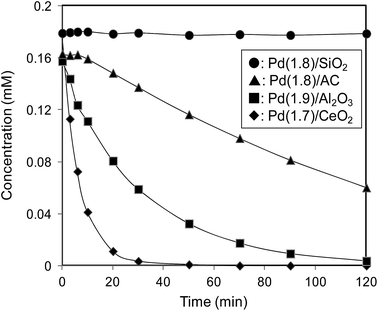 | ||
| Fig. 2 Catalytic HDC of diclofenac over Pd catalysts supported on SiO2, AC, Al2O3 and CeO2. Reaction conditions: pH 9.0. Catalyst dosage: 0.10 g l−1. | ||
The structural property and catalytic activity of supported catalyst may differ with the preparation methods, and impregnation and deposition–precipitation methods are the widely used ones. In this study, two Pd/CeO2 catalysts with nearly identical Pd loadings were respectively prepared by the impregnation method and deposition–precipitation method, and the HDC of diclofenac on the catalysts is compared in Fig. 3. After 30 min of reaction, diclofenac decreased by 98% for dp-Pd(1.7)/CeO2 and 76% for im-Pd(1.8)/CeO2, indicative of a markedly higher catalytic activity of the former. Such a higher catalytic activity of dp-Pd(1.7)/CeO2 could be attributed to its much higher Pd dispersion and smaller Pd particle, as indicated by CO chemisorption (see Table 1).
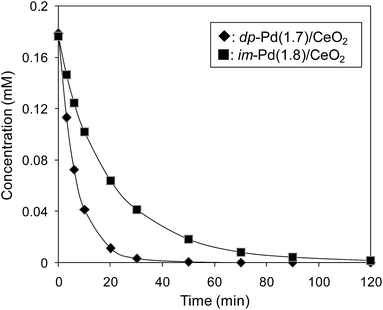 | ||
| Fig. 3 Catalytic HDC of diclofenac over im-Pd(1.8)/CeO2 and dp-Pd(1.7)/CeO2. Reaction conditions: pH 9.0. Catalyst dosage: 0.10 g l−1. | ||
For a heterogeneous reaction, adsorption of the reactant onto catalyst surface is a prerequisite step. To verify the influence of reactant adsorption, the catalytic HDC of diclofenac with varied initial concentrations was conducted, and the results are presented in Fig. 4a. Increasing diclofenac concentration from 0.06 to 0.24 mM led to increased initial activity from 3.9 to 11.6 mM g Cat−1 h−1, implying an adsorption controlled catalysis mechanism. The mechanism could be further testified by fitting the experimental data to the Langmuir–Hinshelwood model:31
 | (1) |
 | (2) |
The dependence of r0 on C0 plotted as 1/C0 versus 1/r0 is shown in Fig. 4b. A linear plot of 1/C0 versus 1/r0 with R2 above 0.99 indicated that the catalytic HDC of diclofenac on dp-Pd(1.7)/CeO2 could be well described using the Langmuir–Hinshelwood model, confirming the adsorption controlled catalysis mechanism.
For the HDC of diclofenac, exposed metallic Pd atoms are considered to be the catalytic active sites. Hence, the catalytic activity of dp-Pd/CeO2 expectedly depends on Pd content. The HDC of diclofenac on dp-Pd/CeO2 catalysts with varied Pd loading amounts is presented in Fig. 5a. Increasing Pd loading amount from 0.45 to 2.6 wt% resulted in an increase of initial reaction rate from 3.5 to 10.5 mM g Cat−1 h−1. Such an enhanced catalytic activity could be ascribed to the increase of exposed Pd sites with Pd loading, as reflected by CO chemisorption. A deep understanding of the relationship between the activity of exposed Pd site and the structure of Pd particle could be obtained by comparing the turnover frequency (TOF) values of exposed Pd atoms in the catalysts. The TOF was defined as the HDC rate of diclofenac per exposed Pd atom within the initial 6 min, in which the numbers of exposed Pd sites in the catalysts were determined using the CO chemisorption method. The results are shown in Fig. 5b. Within the tested particle size range, the TOF value decreased first and then kept nearly constant with Pd particle size. It was previously reported that in the liquid phase catalytic hydrodechlorination the activation of C–Cl bond and H2 was the crucial steps, in which cationic Pd species favored the activation of C–Cl bond, and large Pd particle enhanced H2 activation by forming β-PdH phase.32 For the dp-Pd/CeO2 catalysts, increasing Pd loading amount resulted in larger Pd particles and less cationized Pd species. Hence, the declined activity of exposed Pd atom with Pd loading amount indicated that in comparison with H2 activation the activation of C–Cl bond likely played a more important role in the HDC of diclofenac.
In the catalytic HDC of diclofenac, only partially and completely dechlorinated products were identified. Notably, further hydrogenation of dechlorinated products was previously observed in the HDC of 2,4-dichlorophenol, which was closely related to the used catalysts.33–35 To clarify if further hydrogenation of dechlorinated product could proceed, the catalytic hydrogenation of 2-anilinophenylacetic acid was conducted. The results showed that after reaction for 2 h the concentration of 2-anilinophenylacetic acid kept nearly constant, and other products were not determined by HPLC (see Fig. 5S, ESI†). Hence, the catalytic HDC of diclofenac to 2-anilinophenylacetic acid may process via stepwise or/and concerted pathways, which was described in Scheme 1.
The potential dechlorination mechanism could be verified by fitting the kinetic data using following equations:36
CDF = C0DF![[thin space (1/6-em)]](https://www.rsc.org/images/entities/char_2009.gif) exp(−(k1 + k2)t) exp(−(k1 + k2)t)
| (3) |
 | (4) |
 | (5) |
The catalytic HDC of diclofenac on dp-Pd(1.7)/CeO2 is presented Fig. 6, and the fitting parameters are summarized in Table 3. It was clear that in the HDC of diclofenac the intermediate product 2-(2-Cl)-APA was detected, confirming the stepwise pathway. Additionally, the fitting results gave substantially high rate constants (k2) for the concerted pathway, reflecting a combined stepwise and concerted pathway for HDC of diclofenac. Given identical Pd loading amounts, the k1, k2 and k3 values of dp-Pd(1.7)/CeO2 were higher than those of Pd(1.9)/Al2O3, confirming a higher catalytic HDC activity of the former. Additionally, the k2/k1 ratio of dp-Pd(1.7)/CeO2 was 4.3, much higher than that of Pd(1.9)/Al2O3 (k2/k1 = 3.0). The higher k2/k1 ratio of dp-Pd(1.7)/CeO2 was likely due to the presence of cationized Pd species, favoring the simultaneous adsorption and activation of C–Cl bonds in diclofenac. Furthermore, increasing Pd loading amount from 0.45 to 2.6 wt% resulted in a marked increase of k2/k1 ratio from 2.0 to 4.7. It should be emphasized that for dp-Pd/CeO2 increasing Pd loading amount led to Pd particle growth, as well as slightly weakened metal-support interaction and attenuated cationization of Pd particle. Hence, decreased k2/k1 ratio with Pd loading amount could be expected. Notably, Pd particle sizes of the catalysts varied from 1.16 to 1.71 nm, comparable with the molecular dimension of diclofenac (1.06 nm × 1.09 nm × 0.85 nm, see Fig. 6S, ESI†). Hence, the observed increase of k2/k1 ratio with Pd loading amount is possibly because large Pd particles could provide enough planar Pd space, facilitating simultaneous access to superficial Pd sites by two C–Cl bonds from diclofenac, and thus favoring the dechlorination via the concerted pathway.37,38
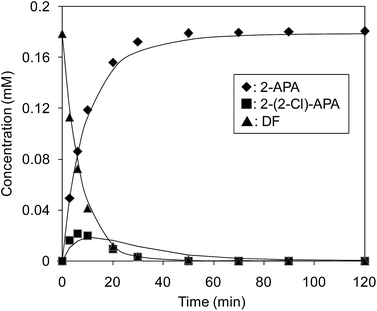 | ||
| Fig. 6 Catalytic HDC of diclofenac on dp-Pd(1.7)/CeO2. Lines represent the fitting curves. Reaction conditions: pH 9.0. Catalyst dosage: 0.10 g l−1. | ||
| Catalysts | k1 | k2 | k3 | k2/k1 | R2 |
|---|---|---|---|---|---|
| Pd(1.9)/Al2O3 | 0.009 | 0.027 | 0.030 | 3.0 | 0.996 |
| dp-Pd(0.45)/CeO2 | 0.01 | 0.02 | 0.03 | 2.0 | 0.998 |
| dp-Pd(0.9)/CeO2 | 0.017 | 0.045 | 0.034 | 2.7 | 0.998 |
| dp-Pd(1.7)/CeO2 | 0.025 | 0.108 | 0.049 | 4.3 | 0.997 |
| dp-Pd(2.6)/CeO2 | 0.028 | 0.132 | 0.053 | 4.7 | 0.995 |
To test the catalyst stability, dp-Pd(1.7)/CeO2 was subjected to 5 consecutive reaction cycles, and the results are presented in Fig. 7. After 5 cycles, the catalytic activity of dp-Pd(1.7)/CeO2 decreased by 75%, indicative a gradual deactivation.
3.3. Toxicity evaluation of original and treated diclofenac solution
The inhibition rate of daphnids as a function of test solution concentration is presented in Fig. 8. The observed inhibition rate of the daphnids increased with diclofenac concentration, reflecting that daphnids were suitable species for the acute toxicity test of diclofenac. The 48 h-EC50 value of diclofenac on test daphnids was calculated to be 21.5% (in % dilution, 95% confidence limits), corresponding to a diclofenac concentration of 0.13 mM. For diclofenac solution treated by catalytic HDC on dp-Pd(1.7)/CeO2, the inhibition rates of the tested daphnids also increased with the proportions of the treated solution. However, the inhibition rates of the treated solutions with dilution ratios of 25% and 37.5% were found to be about 20% and 60%, respectively, indicative of markedly lower toxicity of the treated solution as compared with the original diclofenac solution at the same dilution ratios (independent t-test, p < 0.05). Accordingly, the 48 h-EC50 value of the treated solution on Daphnia magna was 35.1% (in % dilution, 95% confidence limits), much higher than that of original diclofenac solution.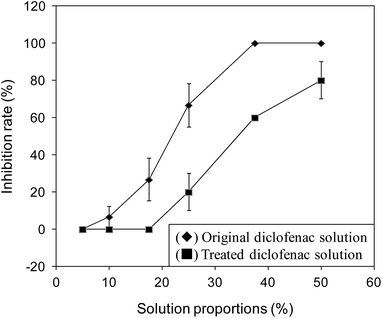 | ||
| Fig. 8 Inhibition rate of daphnids as a function of (♦) original diclofenac solution, and (■) treated diclofenac solution by hydrodechlorination. | ||
The composition of the treated diclofenac solution was further analyzed by high performance liquid chromatograph. Upon HDC on dp-Pd(1.7)/CeO2 for 2 h, the residual diclofenac concentration was below the detection limitation, and the concentrations of 2-(2-Cl)-APA and 2-APA were found to be 0.01 and 0.59 mM, respectively. Hence, the markedly lower toxic effects of the treated solution on Daphnia magna could be attributed to the effective conversion of diclofenac into less toxic 2-APA by the catalytic HDC.
4. Conclusions
In the present study, Pd catalysts supported on AC, SiO2, Al2O3 and CeO2 were prepared and the HDC of diclofenac on the catalysts was investigated. Compared with Pd catalysts with other supports, dp-Pd(1.7)/CeO2 catalyst has a higher Pd dispersion and more cationized Pd species due to the existence of stronger metal support interaction. Accordingly, much higher catalytic activity is shown on dp-Pd(1.7)/CeO2 for the catalytic HDC of diclofenac. Increasing Pd loading amount of dp-Pd/CeO2 catalyst enhances the reductive removal of diclofenac, while the TOF value first decreases and then kept nearly constant with Pd loading amount. Additionally, the catalytic HDC of diclofenac follows the Langmuir–Hinshelwood model, reflecting an adsorption controlled reaction mechanism. The HDC of diclofenac processes via a combined stepwise and concerted pathway, and increasing Pd loading amount favors the concerted pathway. Toxicity test indicates that in comparison with original solution HDC of diclofenac results in markedly decreased toxicity. Findings in the present study highlight promising potentials of using HDC as an effective detoxification method for the abatement of diclofenac pollution in water.Acknowledgements
The financial support from National Key Basic Research Program of China (2014CB441103) and the National Natural Science Foundation of China (no. 21277066, 21225729 and 21237002) is gratefully acknowledged. We are indebted to the Modern Analytical Center, Nanjing University for the catalyst characterization.Notes and references
- D. Stulten, S. Zuhlke, M. Lamshoft and M. Spiteller, Sci. Total Environ., 2008, 405, 310–316 CrossRef PubMed.
- T. A. Ternes, Water Res., 1998, 32(11), 3245–3260 CrossRef CAS.
- T. Heberer, Toxicol. Lett., 2002, 131, 5–17 CrossRef CAS.
- R. Triebskorn, H. Casper, A. Heyd, R. Eikemper, H. R. Kohler and J. Schwaiger, Aquat. Toxicol., 2004, 68, 151–166 CrossRef CAS PubMed.
- M. Cleuvers, Toxicol. Lett., 2003, 142, 185–194 CrossRef CAS.
- M. Cleuvers, Ecotoxicol. Environ. Saf., 2004, 59, 309–315 CrossRef CAS.
- J. L. Acero, F. J. Benitez, F. J. Real and F. Teva, Chem. Eng. J., 2012, 210, 1–8 CrossRef CAS PubMed.
- J. L. Sotelo, A. Rodríguez, S. Álvarez and J. García, Chem. Eng. Res. Des., 2012, 90, 967–974 CrossRef CAS PubMed.
- D. Vogna, R. Marotta, A. Napolitano, R. Andreozzi and M. d'Ischia, Water Res., 2004, 38, 414–422 CrossRef CAS PubMed.
- F. J. Beltran, P. Pocostales, P. Alvarez and A. Oropesa, J. Hazard. Mater., 2009, 163, 768–776 CrossRef CAS PubMed.
- H. Yu, E. Nie, J. Xu, S. Yan, W. J. Cooper and W. Song, Water Res., 2013, 47, 1909–1918 CrossRef CAS PubMed.
- A. Aguinaco, F. J. Beltrán, J. F. García-Araya and A. Oropesa, Chem. Eng. J., 2012, 189–190, 275–282 CrossRef CAS PubMed.
- P. Calza, V. A. Sakkas, C. Medana, C. Baiocchi, A. Dimou, E. Pelizzetti and T. Albanis, Appl. Catal., B, 2006, 67, 197–205 CrossRef CAS PubMed.
- J. Zhou, Y. Han, W. Wang, Z. Xu, H. Wan, D. Yin, S. Zheng and D. Zhu, Appl. Catal., B, 2013, 134–135, 222–230 CrossRef CAS PubMed.
- Y. Shao, Z. Xu, H. Wan, Y. Wan, H. Chen, S. Zheng and D. Zhu, Catal. Commun., 2011, 12, 1405–1409 CrossRef CAS PubMed.
- M. Munoz, Z. M. de Pedro, J. A. Casas and J. J. Rodriguez, Appl. Catal., A, 2014, 488, 78–85 CrossRef CAS PubMed.
- T. Janiak and J. Okal, Appl. Catal., B, 2009, 92, 384–392 CrossRef CAS PubMed.
- S. De Corte, T. Hennebel, J. P. Fitts, T. Sabbe, V. Bliznuk, S. Verschuere, D. van der Lelie, W. Verstraete and N. Boon, Environ. Sci. Technol., 2011, 45, 8506–8513 CrossRef CAS PubMed.
- S. De Corte, T. Sabbe, T. Hennebel, L. Vanhaecke, B. De Gusseme, W. Verstraete and N. Boon, Water Res., 2012, 46, 2718–2726 CrossRef CAS PubMed.
- G. Yuan and M. A. Keane, Chem. Eng. Sci., 2003, 58, 257–267 CrossRef CAS.
- G. Agostini, R. Pellegrini, G. Leofanti, L. Bertinetti, S. Bertarione, E. Groppo, A. Zecchina and C. Lamberti, J. Phys. Chem. C, 2009, 113, 10485–10492 CAS.
- E. Groppo, G. Agostini, A. Piovano, N. B. Muddada, G. Leofanti, R. Pellegrini, G. Portale, A. Longo and C. Lamberti, J. Catal., 2012, 287, 44–54 CrossRef CAS PubMed.
- Organization for Economic Co-operation and Development, OECD guideline for testing of chemicals: Daphnia sp., Acute Immobilisation Test, 2004, vol. 202 Search PubMed.
- L. Xiao, K. Sun, X. Xu and X. Li, Catal. Commun., 2005, 6, 796–801 CrossRef CAS PubMed.
- W. Shen and Y. Matsumura, J. Mol. Catal. A: Chem., 2000, 153, 165–168 CrossRef CAS.
- R. Gopinath, N. Lingaiah, B. Sreedhar, I. Suryanarayana, P. P. S. Sai and A. Obuchi, Appl. Catal., B, 2003, 46, 587–594 CrossRef CAS.
- D. Briggs and M. P. Seah, Practical surface analysis: Auger and X-ray photoelectron spectroscopy, Wiley, 2nd edn, 1990, vol. 1 Search PubMed.
- W. Shen, M. Okumura, Y. Matsumura and M. Haruta, Appl. Catal., A, 2001, 213, 225–232 CrossRef CAS.
- N. S. Babu, N. Lingaiah, R. Gopinath, P. S. Sankar Reddy and P. P. S. Sai, J. Phys. Chem. C, 2007, 111, 6447–6453 CAS.
- H. Chen, Z. Xu, H. Wan, J. Zheng, D. Yin and S. Zheng, Appl. Catal., B, 2010, 96, 307–313 CrossRef CAS PubMed.
- A. Pintar, J. Batista, J. Levec and T. Kajiuchi, Appl. Catal., B, 1996, 11, 81–98 CrossRef CAS.
- J. A. Baeza, L. Calvo, M. A. Gilarranz, A. F. Mohedano, J. A. Casas and J. J. Rodriguez, J. Catal., 2012, 293, 85–93 CrossRef CAS PubMed.
- I. Witonska, A. Krolak and S. Karski, J. Mol. Catal. A: Chem., 2010, 331, 21–28 CrossRef CAS PubMed.
- I. A. Witonska, M. J. Walock, M. Binczarski, M. Lesiak, A. V. Stanishevsky and S. Karski, J. Mol. Catal. A: Chem., 2014, 393, 248–256 CrossRef CAS PubMed.
- S. Gomez-Quero, F. Cardenas-Lizana and M. A. Keane, Ind. Eng. Chem. Res., 2008, 47, 6841–6853 CrossRef CAS.
- E. Díaz, J. A. Casas, Á. F. Mohedano, L. Calvo, M. A. Gilarranz and J. J. Rodríguez, Ind. Eng. Chem. Res., 2008, 47, 3840–3846 CrossRef.
- B. Coq, J. M. Cognion, F. Figueras and D. Tournigant, J. Catal., 1993, 141(1), 21–33 CrossRef CAS.
- Z. Karpinski, K. Early and J. L. d'Itri, J. Catal., 1996, 164, 378–386 CrossRef CAS.
Footnote |
| † Electronic supplementary information (ESI) available. See DOI: 10.1039/c4ra16674d |
| This journal is © The Royal Society of Chemistry 2015 |

